Data Analytics Assignment: Guesstimation of Scenarios at NUS
VerifiedAdded on 2023/04/25
|7
|1349
|129
Homework Assignment
AI Summary
This assignment delves into the realm of data analytics through guesstimation, exploring real-world scenarios to estimate quantities and interactions. It addresses three specific situations: estimating the number of people using a lift in the Mochtar Riady building at the National University of Singapore (NUS), approximating the number of people an individual interacts with in a year, and calculating the total distance walked by males and females during their respective lifespans based on average daily steps and life expectancy data. The analysis involves making logical assumptions, applying mathematical calculations, and referencing relevant sources to arrive at reasonable estimations for each scenario. The assignment demonstrates the application of analytical skills to everyday situations, highlighting the importance of data-driven estimations and informed decision-making.
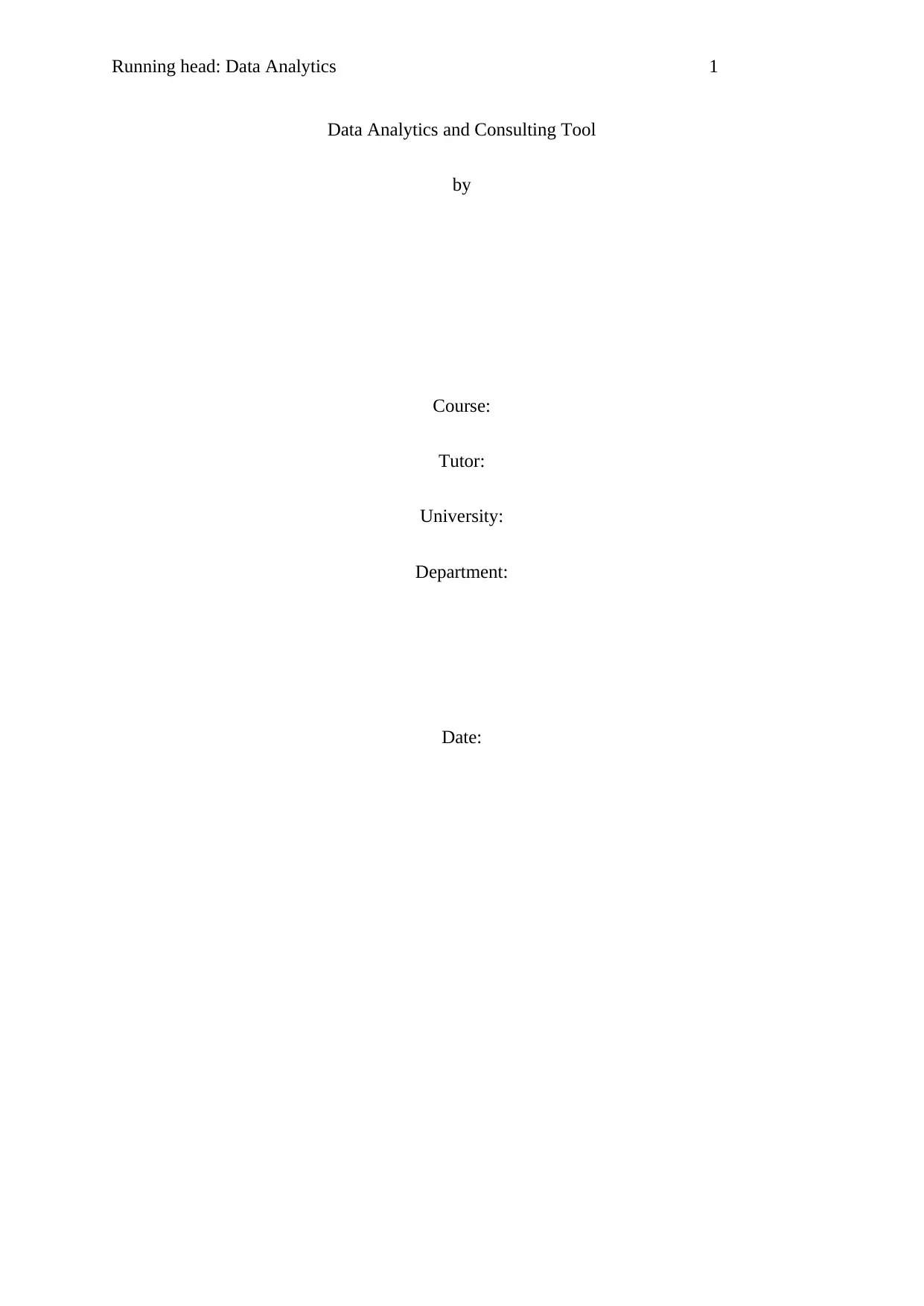
Running head: Data Analytics 1
Data Analytics and Consulting Tool
by
Course:
Tutor:
University:
Department:
Date:
Data Analytics and Consulting Tool
by
Course:
Tutor:
University:
Department:
Date:
Paraphrase This Document
Need a fresh take? Get an instant paraphrase of this document with our AI Paraphraser
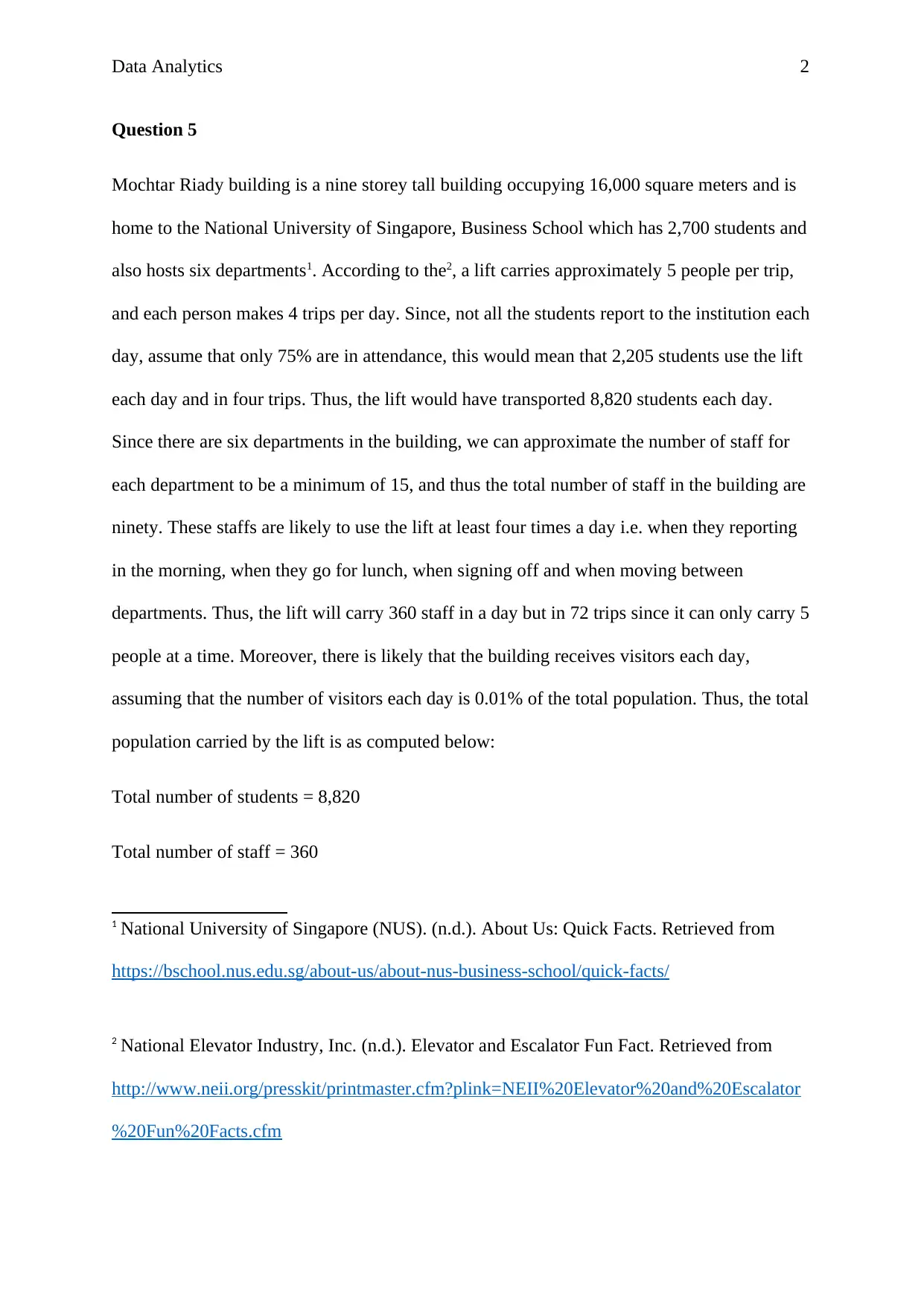
Data Analytics 2
Question 5
Mochtar Riady building is a nine storey tall building occupying 16,000 square meters and is
home to the National University of Singapore, Business School which has 2,700 students and
also hosts six departments1. According to the2, a lift carries approximately 5 people per trip,
and each person makes 4 trips per day. Since, not all the students report to the institution each
day, assume that only 75% are in attendance, this would mean that 2,205 students use the lift
each day and in four trips. Thus, the lift would have transported 8,820 students each day.
Since there are six departments in the building, we can approximate the number of staff for
each department to be a minimum of 15, and thus the total number of staff in the building are
ninety. These staffs are likely to use the lift at least four times a day i.e. when they reporting
in the morning, when they go for lunch, when signing off and when moving between
departments. Thus, the lift will carry 360 staff in a day but in 72 trips since it can only carry 5
people at a time. Moreover, there is likely that the building receives visitors each day,
assuming that the number of visitors each day is 0.01% of the total population. Thus, the total
population carried by the lift is as computed below:
Total number of students = 8,820
Total number of staff = 360
1 National University of Singapore (NUS). (n.d.). About Us: Quick Facts. Retrieved from
https://bschool.nus.edu.sg/about-us/about-nus-business-school/quick-facts/
2 National Elevator Industry, Inc. (n.d.). Elevator and Escalator Fun Fact. Retrieved from
http://www.neii.org/presskit/printmaster.cfm?plink=NEII%20Elevator%20and%20Escalator
%20Fun%20Facts.cfm
Question 5
Mochtar Riady building is a nine storey tall building occupying 16,000 square meters and is
home to the National University of Singapore, Business School which has 2,700 students and
also hosts six departments1. According to the2, a lift carries approximately 5 people per trip,
and each person makes 4 trips per day. Since, not all the students report to the institution each
day, assume that only 75% are in attendance, this would mean that 2,205 students use the lift
each day and in four trips. Thus, the lift would have transported 8,820 students each day.
Since there are six departments in the building, we can approximate the number of staff for
each department to be a minimum of 15, and thus the total number of staff in the building are
ninety. These staffs are likely to use the lift at least four times a day i.e. when they reporting
in the morning, when they go for lunch, when signing off and when moving between
departments. Thus, the lift will carry 360 staff in a day but in 72 trips since it can only carry 5
people at a time. Moreover, there is likely that the building receives visitors each day,
assuming that the number of visitors each day is 0.01% of the total population. Thus, the total
population carried by the lift is as computed below:
Total number of students = 8,820
Total number of staff = 360
1 National University of Singapore (NUS). (n.d.). About Us: Quick Facts. Retrieved from
https://bschool.nus.edu.sg/about-us/about-nus-business-school/quick-facts/
2 National Elevator Industry, Inc. (n.d.). Elevator and Escalator Fun Fact. Retrieved from
http://www.neii.org/presskit/printmaster.cfm?plink=NEII%20Elevator%20and%20Escalator
%20Fun%20Facts.cfm
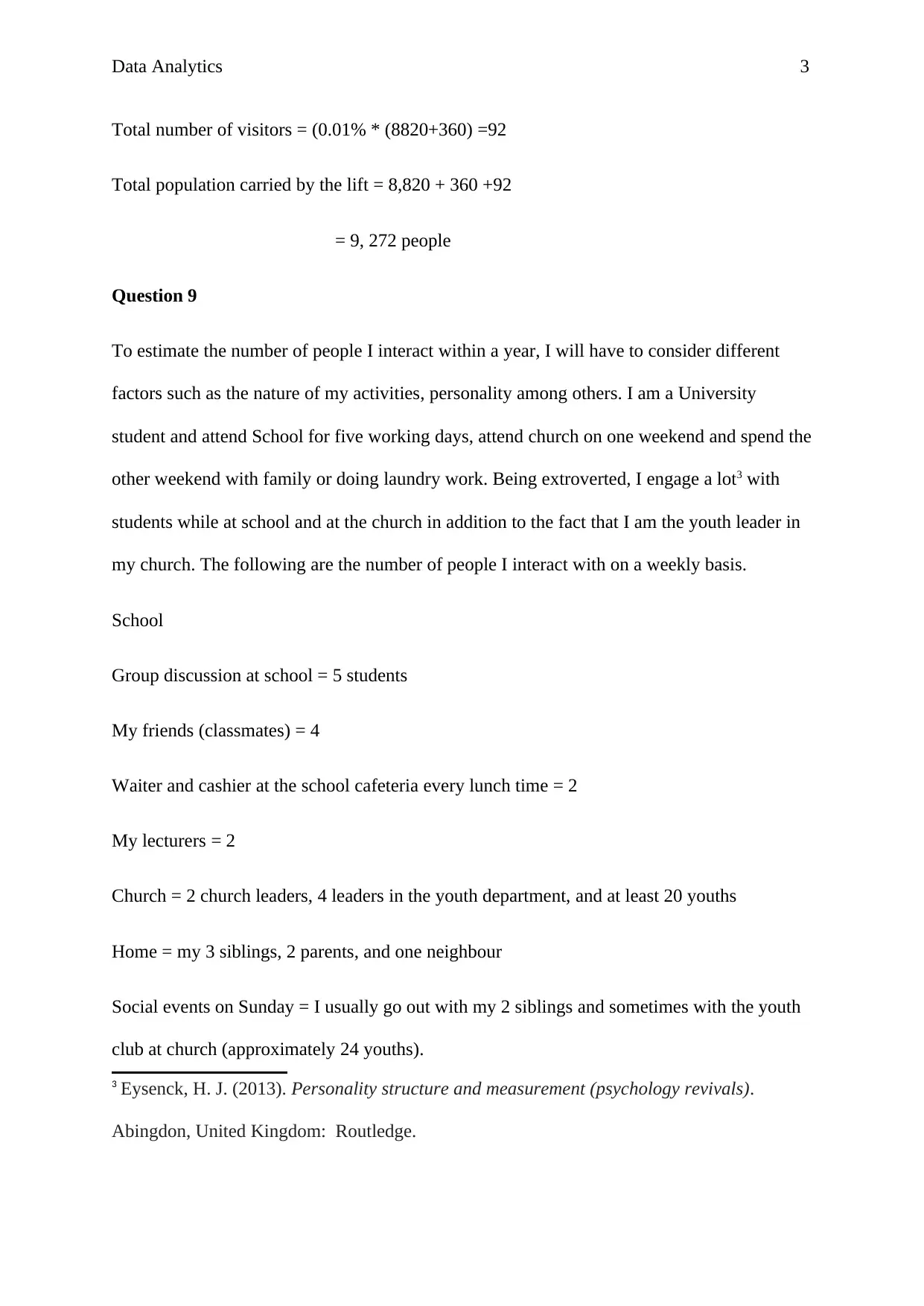
Data Analytics 3
Total number of visitors = (0.01% * (8820+360) =92
Total population carried by the lift = 8,820 + 360 +92
= 9, 272 people
Question 9
To estimate the number of people I interact within a year, I will have to consider different
factors such as the nature of my activities, personality among others. I am a University
student and attend School for five working days, attend church on one weekend and spend the
other weekend with family or doing laundry work. Being extroverted, I engage a lot3 with
students while at school and at the church in addition to the fact that I am the youth leader in
my church. The following are the number of people I interact with on a weekly basis.
School
Group discussion at school = 5 students
My friends (classmates) = 4
Waiter and cashier at the school cafeteria every lunch time = 2
My lecturers = 2
Church = 2 church leaders, 4 leaders in the youth department, and at least 20 youths
Home = my 3 siblings, 2 parents, and one neighbour
Social events on Sunday = I usually go out with my 2 siblings and sometimes with the youth
club at church (approximately 24 youths).
3 Eysenck, H. J. (2013). Personality structure and measurement (psychology revivals).
Abingdon, United Kingdom: Routledge.
Total number of visitors = (0.01% * (8820+360) =92
Total population carried by the lift = 8,820 + 360 +92
= 9, 272 people
Question 9
To estimate the number of people I interact within a year, I will have to consider different
factors such as the nature of my activities, personality among others. I am a University
student and attend School for five working days, attend church on one weekend and spend the
other weekend with family or doing laundry work. Being extroverted, I engage a lot3 with
students while at school and at the church in addition to the fact that I am the youth leader in
my church. The following are the number of people I interact with on a weekly basis.
School
Group discussion at school = 5 students
My friends (classmates) = 4
Waiter and cashier at the school cafeteria every lunch time = 2
My lecturers = 2
Church = 2 church leaders, 4 leaders in the youth department, and at least 20 youths
Home = my 3 siblings, 2 parents, and one neighbour
Social events on Sunday = I usually go out with my 2 siblings and sometimes with the youth
club at church (approximately 24 youths).
3 Eysenck, H. J. (2013). Personality structure and measurement (psychology revivals).
Abingdon, United Kingdom: Routledge.
⊘ This is a preview!⊘
Do you want full access?
Subscribe today to unlock all pages.

Trusted by 1+ million students worldwide
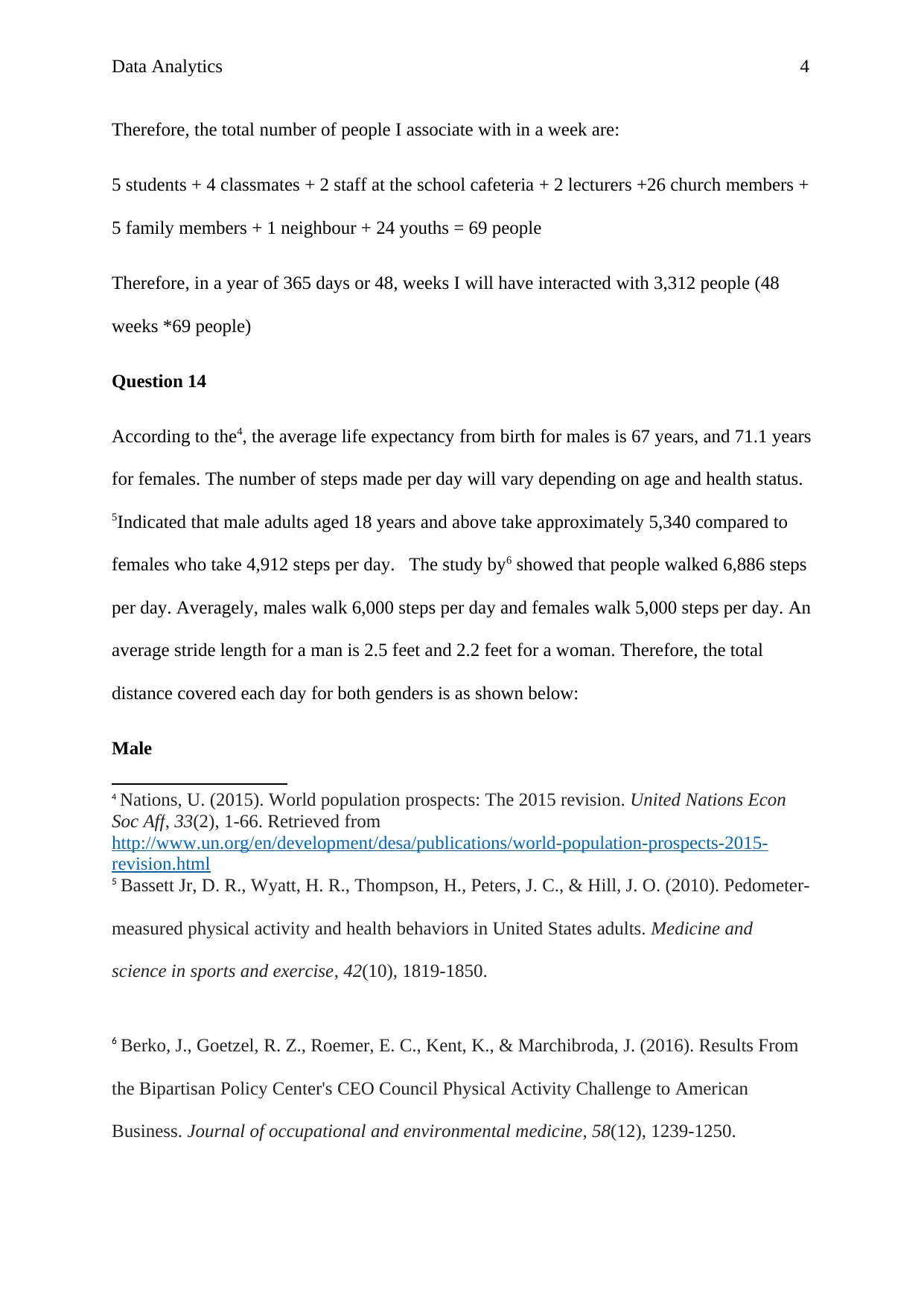
Data Analytics 4
Therefore, the total number of people I associate with in a week are:
5 students + 4 classmates + 2 staff at the school cafeteria + 2 lecturers +26 church members +
5 family members + 1 neighbour + 24 youths = 69 people
Therefore, in a year of 365 days or 48, weeks I will have interacted with 3,312 people (48
weeks *69 people)
Question 14
According to the4, the average life expectancy from birth for males is 67 years, and 71.1 years
for females. The number of steps made per day will vary depending on age and health status.
5Indicated that male adults aged 18 years and above take approximately 5,340 compared to
females who take 4,912 steps per day. The study by6 showed that people walked 6,886 steps
per day. Averagely, males walk 6,000 steps per day and females walk 5,000 steps per day. An
average stride length for a man is 2.5 feet and 2.2 feet for a woman. Therefore, the total
distance covered each day for both genders is as shown below:
Male
4 Nations, U. (2015). World population prospects: The 2015 revision. United Nations Econ
Soc Aff, 33(2), 1-66. Retrieved from
http://www.un.org/en/development/desa/publications/world-population-prospects-2015-
revision.html
5 Bassett Jr, D. R., Wyatt, H. R., Thompson, H., Peters, J. C., & Hill, J. O. (2010). Pedometer-
measured physical activity and health behaviors in United States adults. Medicine and
science in sports and exercise, 42(10), 1819-1850.
6 Berko, J., Goetzel, R. Z., Roemer, E. C., Kent, K., & Marchibroda, J. (2016). Results From
the Bipartisan Policy Center's CEO Council Physical Activity Challenge to American
Business. Journal of occupational and environmental medicine, 58(12), 1239-1250.
Therefore, the total number of people I associate with in a week are:
5 students + 4 classmates + 2 staff at the school cafeteria + 2 lecturers +26 church members +
5 family members + 1 neighbour + 24 youths = 69 people
Therefore, in a year of 365 days or 48, weeks I will have interacted with 3,312 people (48
weeks *69 people)
Question 14
According to the4, the average life expectancy from birth for males is 67 years, and 71.1 years
for females. The number of steps made per day will vary depending on age and health status.
5Indicated that male adults aged 18 years and above take approximately 5,340 compared to
females who take 4,912 steps per day. The study by6 showed that people walked 6,886 steps
per day. Averagely, males walk 6,000 steps per day and females walk 5,000 steps per day. An
average stride length for a man is 2.5 feet and 2.2 feet for a woman. Therefore, the total
distance covered each day for both genders is as shown below:
Male
4 Nations, U. (2015). World population prospects: The 2015 revision. United Nations Econ
Soc Aff, 33(2), 1-66. Retrieved from
http://www.un.org/en/development/desa/publications/world-population-prospects-2015-
revision.html
5 Bassett Jr, D. R., Wyatt, H. R., Thompson, H., Peters, J. C., & Hill, J. O. (2010). Pedometer-
measured physical activity and health behaviors in United States adults. Medicine and
science in sports and exercise, 42(10), 1819-1850.
6 Berko, J., Goetzel, R. Z., Roemer, E. C., Kent, K., & Marchibroda, J. (2016). Results From
the Bipartisan Policy Center's CEO Council Physical Activity Challenge to American
Business. Journal of occupational and environmental medicine, 58(12), 1239-1250.
Paraphrase This Document
Need a fresh take? Get an instant paraphrase of this document with our AI Paraphraser
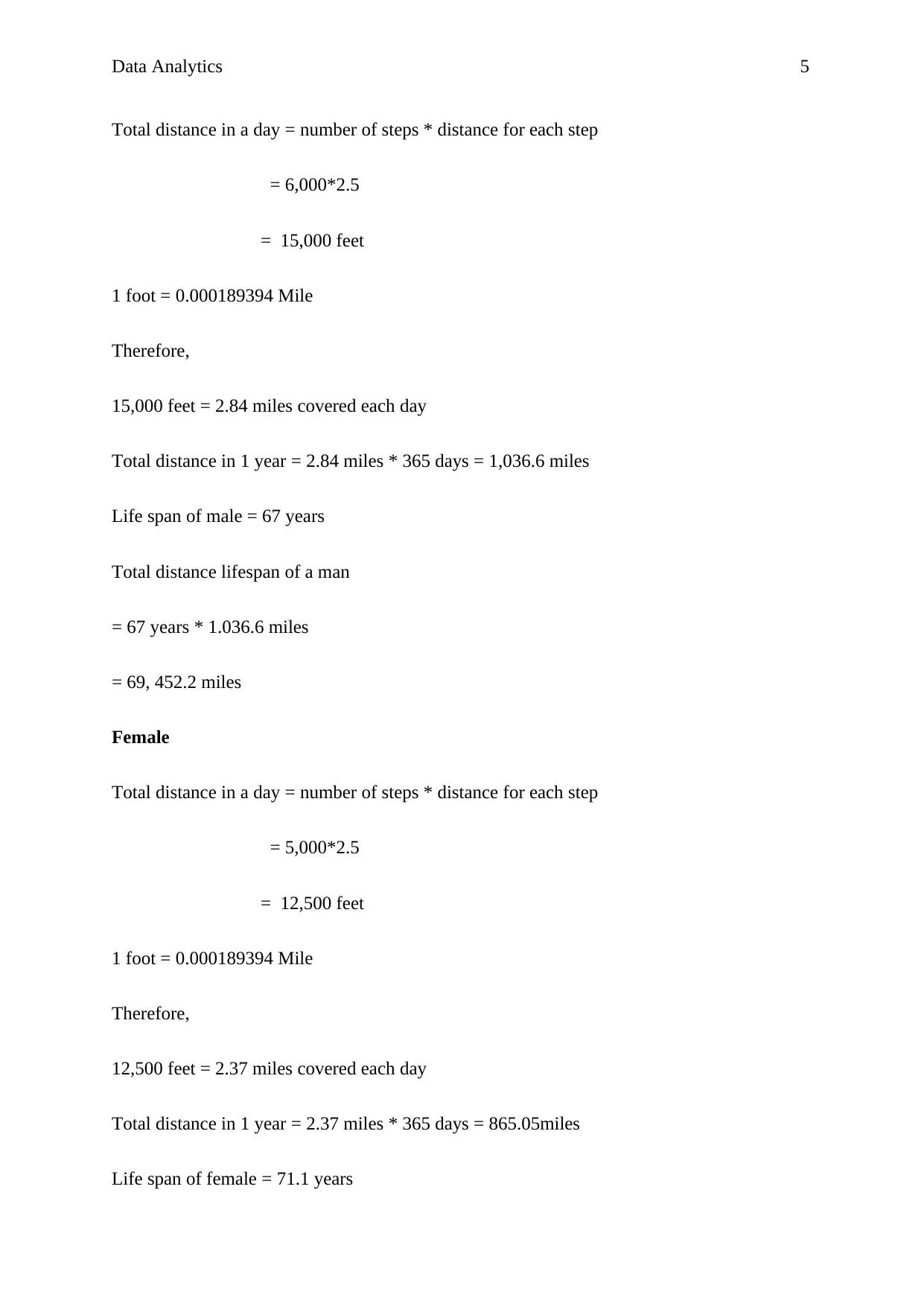
Data Analytics 5
Total distance in a day = number of steps * distance for each step
= 6,000*2.5
= 15,000 feet
1 foot = 0.000189394 Mile
Therefore,
15,000 feet = 2.84 miles covered each day
Total distance in 1 year = 2.84 miles * 365 days = 1,036.6 miles
Life span of male = 67 years
Total distance lifespan of a man
= 67 years * 1.036.6 miles
= 69, 452.2 miles
Female
Total distance in a day = number of steps * distance for each step
= 5,000*2.5
= 12,500 feet
1 foot = 0.000189394 Mile
Therefore,
12,500 feet = 2.37 miles covered each day
Total distance in 1 year = 2.37 miles * 365 days = 865.05miles
Life span of female = 71.1 years
Total distance in a day = number of steps * distance for each step
= 6,000*2.5
= 15,000 feet
1 foot = 0.000189394 Mile
Therefore,
15,000 feet = 2.84 miles covered each day
Total distance in 1 year = 2.84 miles * 365 days = 1,036.6 miles
Life span of male = 67 years
Total distance lifespan of a man
= 67 years * 1.036.6 miles
= 69, 452.2 miles
Female
Total distance in a day = number of steps * distance for each step
= 5,000*2.5
= 12,500 feet
1 foot = 0.000189394 Mile
Therefore,
12,500 feet = 2.37 miles covered each day
Total distance in 1 year = 2.37 miles * 365 days = 865.05miles
Life span of female = 71.1 years
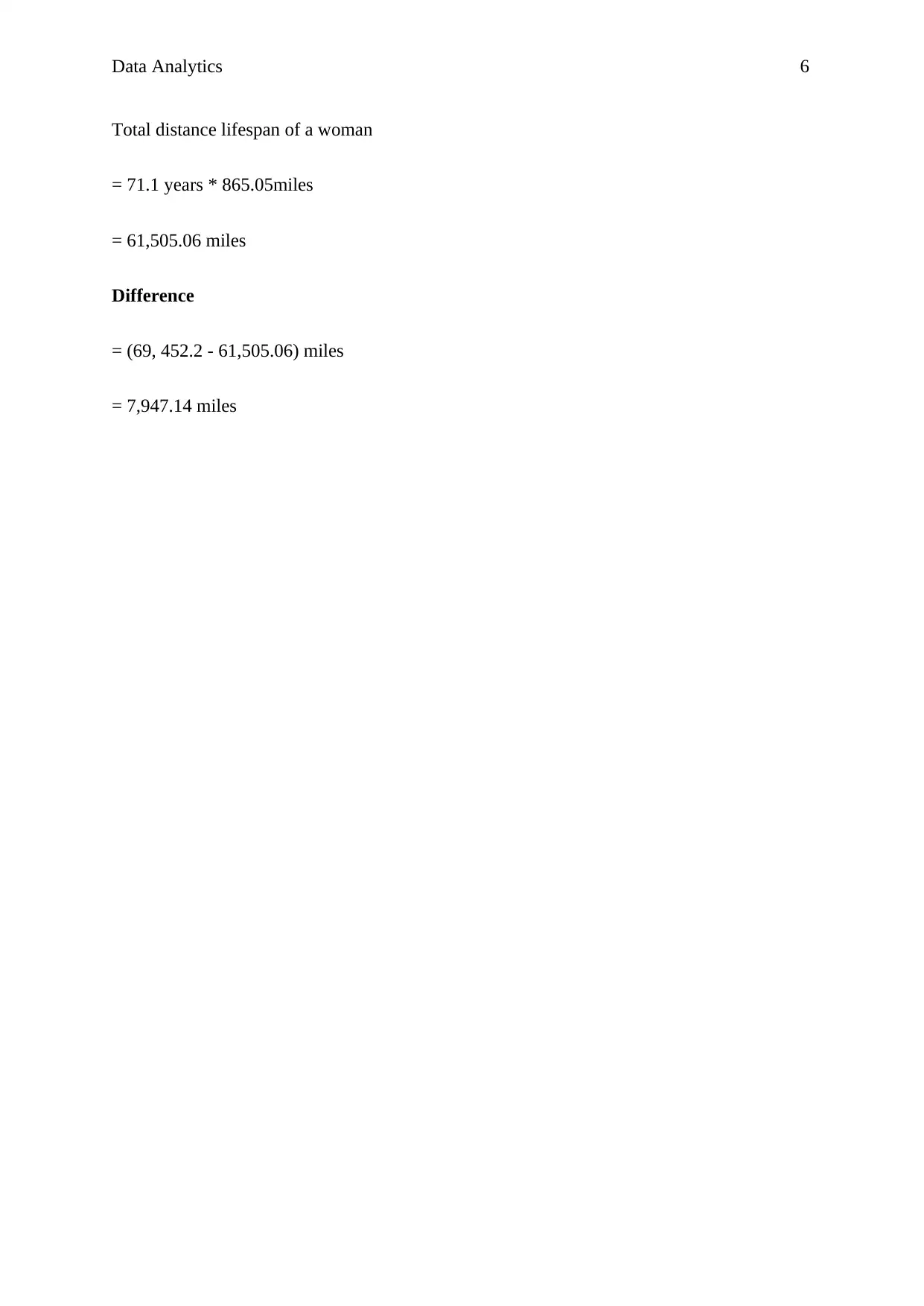
Data Analytics 6
Total distance lifespan of a woman
= 71.1 years * 865.05miles
= 61,505.06 miles
Difference
= (69, 452.2 - 61,505.06) miles
= 7,947.14 miles
Total distance lifespan of a woman
= 71.1 years * 865.05miles
= 61,505.06 miles
Difference
= (69, 452.2 - 61,505.06) miles
= 7,947.14 miles
⊘ This is a preview!⊘
Do you want full access?
Subscribe today to unlock all pages.

Trusted by 1+ million students worldwide
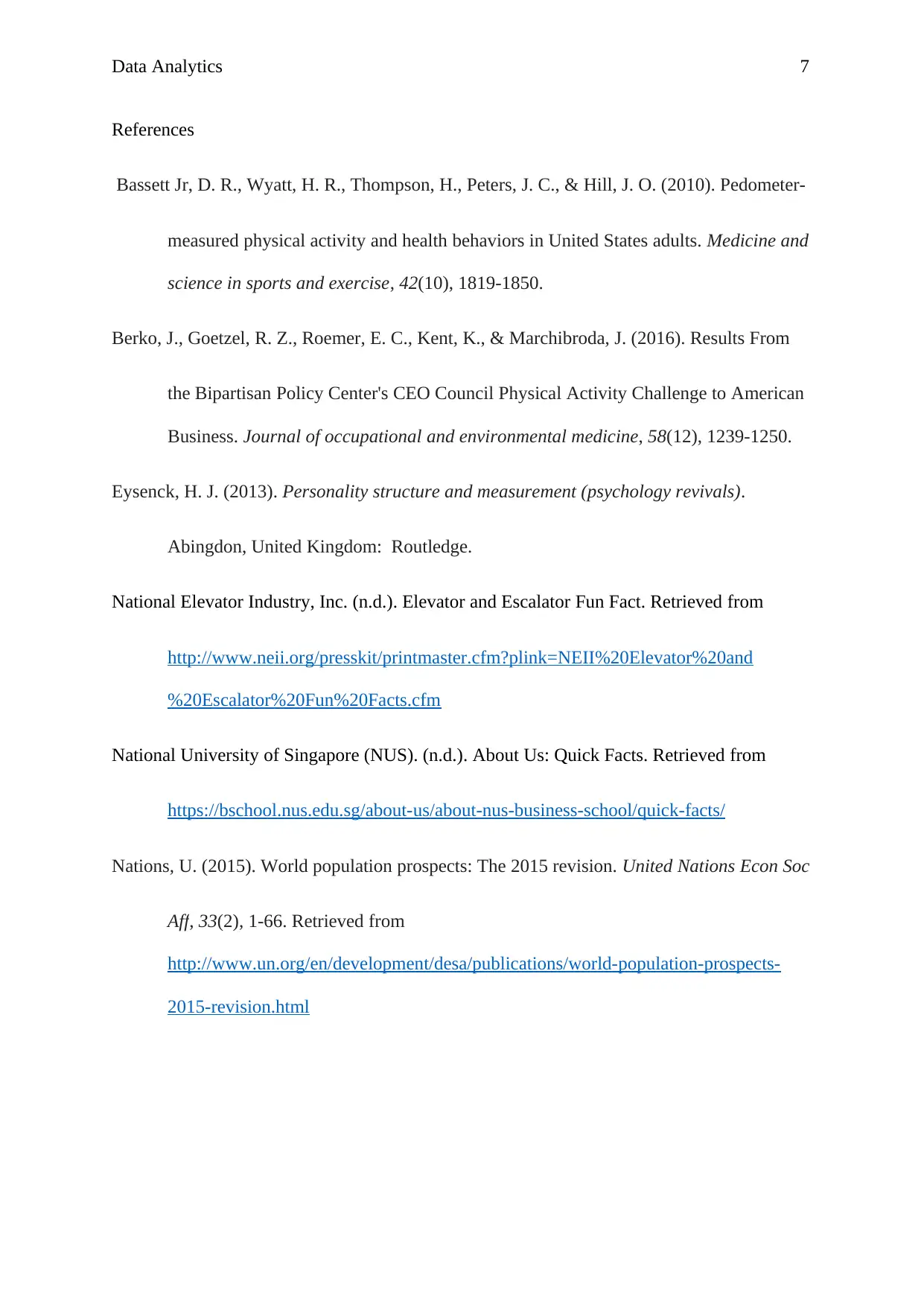
Data Analytics 7
References
Bassett Jr, D. R., Wyatt, H. R., Thompson, H., Peters, J. C., & Hill, J. O. (2010). Pedometer-
measured physical activity and health behaviors in United States adults. Medicine and
science in sports and exercise, 42(10), 1819-1850.
Berko, J., Goetzel, R. Z., Roemer, E. C., Kent, K., & Marchibroda, J. (2016). Results From
the Bipartisan Policy Center's CEO Council Physical Activity Challenge to American
Business. Journal of occupational and environmental medicine, 58(12), 1239-1250.
Eysenck, H. J. (2013). Personality structure and measurement (psychology revivals).
Abingdon, United Kingdom: Routledge.
National Elevator Industry, Inc. (n.d.). Elevator and Escalator Fun Fact. Retrieved from
http://www.neii.org/presskit/printmaster.cfm?plink=NEII%20Elevator%20and
%20Escalator%20Fun%20Facts.cfm
National University of Singapore (NUS). (n.d.). About Us: Quick Facts. Retrieved from
https://bschool.nus.edu.sg/about-us/about-nus-business-school/quick-facts/
Nations, U. (2015). World population prospects: The 2015 revision. United Nations Econ Soc
Aff, 33(2), 1-66. Retrieved from
http://www.un.org/en/development/desa/publications/world-population-prospects-
2015-revision.html
References
Bassett Jr, D. R., Wyatt, H. R., Thompson, H., Peters, J. C., & Hill, J. O. (2010). Pedometer-
measured physical activity and health behaviors in United States adults. Medicine and
science in sports and exercise, 42(10), 1819-1850.
Berko, J., Goetzel, R. Z., Roemer, E. C., Kent, K., & Marchibroda, J. (2016). Results From
the Bipartisan Policy Center's CEO Council Physical Activity Challenge to American
Business. Journal of occupational and environmental medicine, 58(12), 1239-1250.
Eysenck, H. J. (2013). Personality structure and measurement (psychology revivals).
Abingdon, United Kingdom: Routledge.
National Elevator Industry, Inc. (n.d.). Elevator and Escalator Fun Fact. Retrieved from
http://www.neii.org/presskit/printmaster.cfm?plink=NEII%20Elevator%20and
%20Escalator%20Fun%20Facts.cfm
National University of Singapore (NUS). (n.d.). About Us: Quick Facts. Retrieved from
https://bschool.nus.edu.sg/about-us/about-nus-business-school/quick-facts/
Nations, U. (2015). World population prospects: The 2015 revision. United Nations Econ Soc
Aff, 33(2), 1-66. Retrieved from
http://www.un.org/en/development/desa/publications/world-population-prospects-
2015-revision.html
1 out of 7
Your All-in-One AI-Powered Toolkit for Academic Success.
+13062052269
info@desklib.com
Available 24*7 on WhatsApp / Email
![[object Object]](/_next/static/media/star-bottom.7253800d.svg)
Unlock your academic potential
Copyright © 2020–2025 A2Z Services. All Rights Reserved. Developed and managed by ZUCOL.